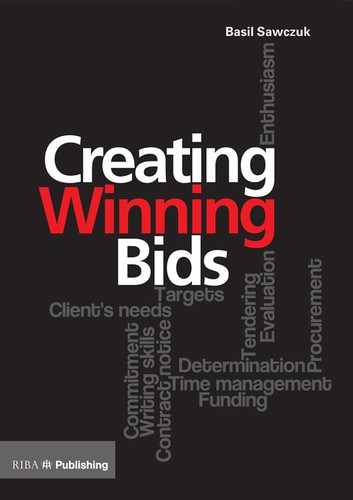Book Description
'Creating Winning Bids' sets out the key stages in the production of a winning bid. Based on tried and tested methods, and using a simple step-by-step process, it will improve your chances of success in what can otherwise seem a daunting and complex process. Distilling the author’s experience of over 25 years of bidding in the public and private sectors, it is packed with practical tips about what your client really wants to see. Beginning with a concise look at how to find new opportunities for work, it examines the various types of bid that can be made and includes invaluable explanations of the jargon used in the bidding process – from OJEU to PQQs.
Illustrated throughout with useful diagrams and checklists, and covering a range of procurement routes, this guide will help anyone from the sole practitioner to the large firm with a dedicated bidding team to create practical and perfectly-tailored winning bids.
Table of Contents
- Cover
- Title
- Copyright
- Contents
- Dedication
- About the author
- CHAPTER 1 FINDING OPPORTUNITIES TO BID FOR WORK
- CHAPTER 2 WHAT TO ESTABLISH BEFORE TENDER OR PRE-QUALIFICATION RELEASE
- CHAPTER 3 CREDIBILITY, CAPABILITY, COMPATIBILITY AND RELIABILITY (THE 3Cs + R TEST)
- CHAPTER 4 IMPROVING YOUR CHANCES OF SUCCESS THROUGH BETTER UNDERSTANDING OF YOUR COMPETITORS
- Is there a favourite already?
- How to win if there is a favourite
- If there is an incumbent, focus on the service gap
- What to do if you are the incumbent
- Compare yourself to the competition
- Differentiate yourself from your competitors to increase your chances of success
- Differentiate through customer service
- Maximising your strengths and subtly revealing the weaknesses in your competition
- CHAPTER 5 PREPARATION AND PLANNING THE PROCESS
- CHAPTER 6 CREATING THE DOCUMENT
- The seven-step checklist on content – the ‘must have’ elements
- Step 1: Write the content to address the evaluation criteria
- Step 2: Do you pass the ‘so what?’ test (all about features and benefits)
- Step 3: Address all the issues the client may have
- Step 4: Use the client’s language
- Step 5: See your answer from the client’s point of view
- Step 6: Create a reason to select your proposal
- Step 7: Be compliant
- Writing an executive summary
- Principles of clear writing
- Avoid being sidetracked when writing
- Structuring the answer
- Layout and style
- Patterns, signposts and bridges
- Using lists, tables and graphics
- CHAPTER 7 USING APPENDICES
- CHAPTER 8 SHOWING OFF PAST PROJECTS
- CHAPTER 9 OTHER CONSIDERATIONS
- INDEX
